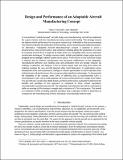| dc.description.abstract | In conventional “vehicle-focused” aircraft design and manufacturing, aircraft are optimized for a given mission and then manufactured using custom-built tooling. This strategy ensures the highest vehicle performance for any given mission but is inflexible in that accommodating new missions requires the production of new tooling, a time-consuming and expensive process. An alternative, “Adaptable Aircraft Manufacturing” concept, is explored in which a structural bus, interconnect system, and subsection molding allows the production of a series of composite aircraft from a single set of molds which are compatible with vacuum-autoclave construction techniques. To design common molds, airfoils and planform taper angle must be designed across multiple vehicles’ performance spaces. Performance of any individual design is reduced due to inherent aerodynamic and structural inefficiencies of the adaptably-manufactured airframe, but molding costs and production time are greatly reduced. By molding a subsection, the designer is free to choose aspect ratio and wing area within the molding envelope for new aircraft designed after mold fabrication. In applications where development time and robustness to changes in mission specification is more important than individual aircraft performance, this concept provides significant advantages. To demonstrate the feasibility of the concept, three UAVs of differing sizes (a hand-launched UAV, a reconnaissance UAV, and a multi-payload UAV) were constructed from a single set of molds. The aircraft were constructed, flight-tested, and their performance evaluated to determine the benefits and penalties of this approach as compared to three virtual, equivalent, conventionally-manufactured aircraft. The adaptably-manufactured aircraft are estimated to suffer an average of 8% increase in weight and a reduction of 17% in endurance. The benefit is a reduction of 58% of tooling material and labor and a reduction of 56% in build time as compared to the manufacturing of three individual, conventionally-built aircraft. | en_US |
